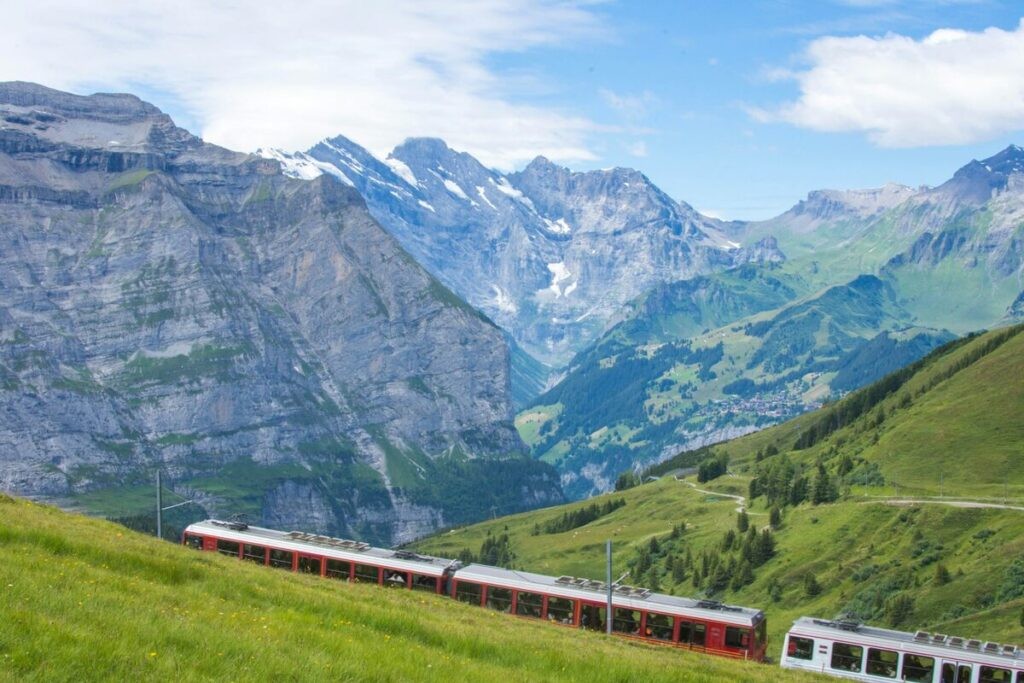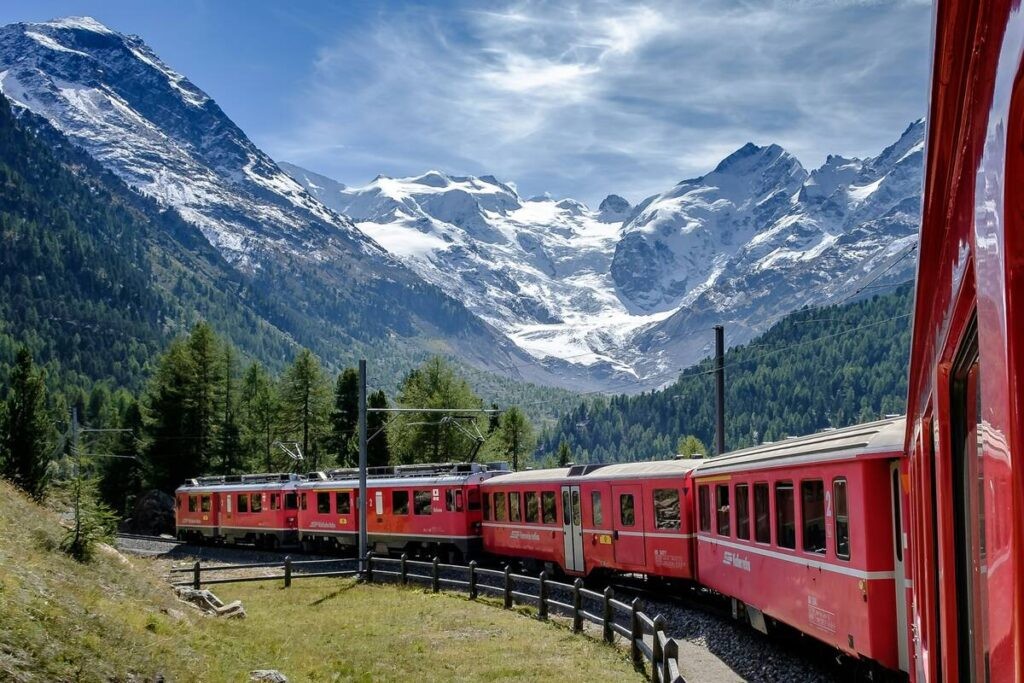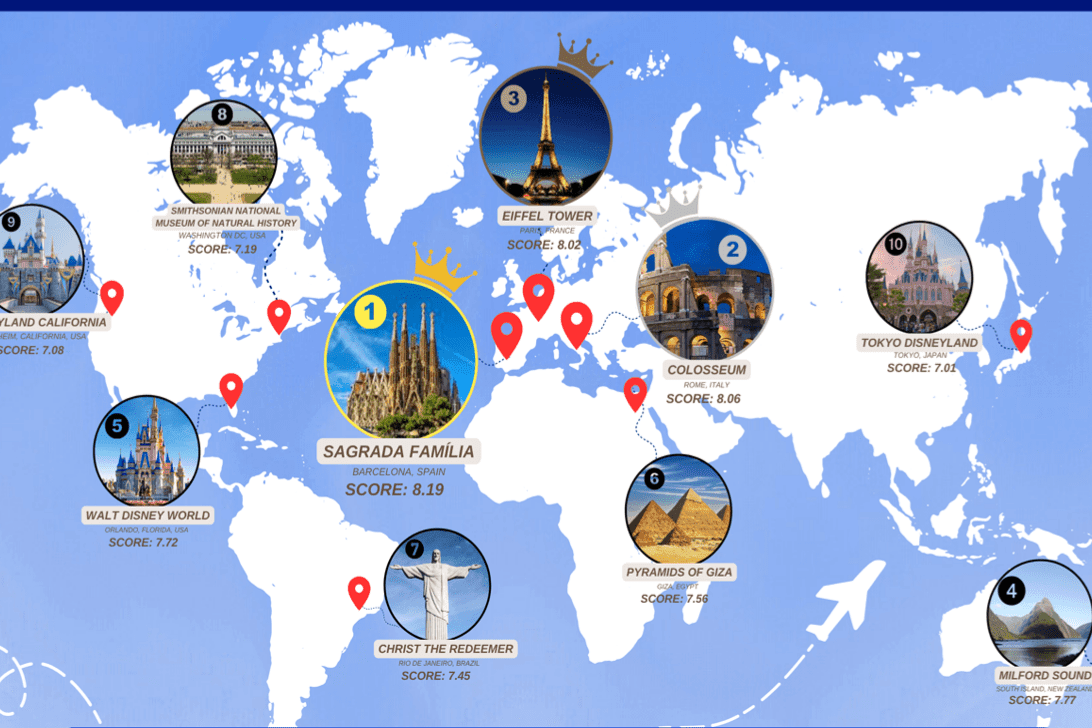- More Than Mountains: The Allure of Alpine Train Travel
- From Iconic Routes to Hidden Corners: Mapping Your Journey
- Suggested Routes for One or Two Weeks in the Alps
- Make the Most of Every Stop: Go Luggage-Free with Stasher
- Let the Journey Lead You: Why Rail Passes Are Made for the Alps
- Slow Travel Tips for the Ultimate Alpine Escape
- A 7-Day Alpine Itinerary
- Day 1: Geneva → Zermatt
- Day 2: Zermatt → Chur via Glacier Express
- Day 3: Chur → Tirano via Bernina Express → Overnight in Samedan
- Day 4: Samedan → Spiez → Meiringen
- Day 5: Meiringen → Lucerne → Bad Gastein
- Day 6: Bad Gastein → Lienz
- Day 7: Lienz → Villach → Salzburg
More Than Mountains: The Allure of Alpine Train Travel
There’s something almost cinematic about winding through the Alps by train. One moment you’re passing mirror-like lakes, and the next, you’re slicing through snow-dusted peaks or spotting a lone chalet perched high above a valley. Unlike flying or driving, rail travel in the Alps invites you to slow down and soak in the drama of the landscape, glass windowpanes acting like giant postcards that shift with every turn.
What makes this kind of journey truly special is how accessible it is. With an Interrail or Eurail Pass in your pocket, you’re not locked into a rigid schedule or fixed route—you’re free to follow the mountains wherever they lead. Whether it’s jumping off at a station just because the view looked incredible, or deciding on a whim to stay overnight in a lakeside town, the Alps become your playground. And with train stations often tucked into the heart of villages and valleys, you’re never far from your next breathtaking view or warm, cheese-filled meal.
To avoid confusion – throughout this article, whenever we mention Interrail and Eurail Passes, they are essentially the same Pass, but just have varying eligibility. For European residents (including the UK), you can purchase an Interrail Pass. If you are resident outside of Europe, then you need to purchase the Eurail Pass.
Book your Interrail or Eurail Pass here.
From Iconic Routes to Hidden Corners: Mapping Your Journey
The Alps are home to some of Europe’s most legendary train routes, and they deserve their fame. The Glacier Express (from Zermatt to St. Moritz) is a slow-motion panorama reel of Switzerland’s natural grandeur, passing over 291 bridges and through 91 tunnels. The Bernina Express, which connects Chur with Tirano in Italy, makes an unforgettable descent from icy glaciers to sun-soaked palm trees in just a few hours. And then there’s the GoldenPass Line, sweeping you from Lucerne to Montreux through rolling hills and vineyard-clad slopes.
But some of the most rewarding moments happen off those headline routes. The charm of the Alps often lives in its quieter corners—the places that rarely make the top 10 lists, but stay with you long after your trip ends.
Picture this: a calm morning in Spiez, where the lake reflects a hilltop castle and the air smells like pine. Or Bad Gastein, a spa town where old-world hotels cling to steep cliffs, and thermal waters steam through art deco fountains. Perhaps you find yourself in Tarvisio, Italy, near the borders of Austria and Slovenia, where coffee and strudel share space on the same menu, and alpine trails wind through near-empty forests.
Other spots worth your attention include Lienz, Austria’s sunniest town; Domodossola, a relaxed Italian market hub that feels like a secret base for mountain adventures; and Meiringen, home to waterfalls, hiking trails, and a surprisingly deep connection to Sherlock Holmes.
These places remind you that rail travel isn’t just about getting from A to B—it’s about stumbling across places that you never meant to find.
Suggested Routes for One or Two Weeks in the Alps
One of the joys of an Interrail or Eurail Pass is that you don’t need to plan every detail. Still, it helps to have a rough loop in mind—especially if you’re traveling for a week or two. Here are two sample itineraries that blend must-see routes with lesser-known gems:
One-Week Idea: The Classic Loop with a Twist
- Start in Geneva, taking in the lake before heading toward the mountains.
- Ride the Glacier Express from Zermatt to St. Moritz, with a stop in Brig or Spiez.
- Continue on to Chur, then take the Bernina Express to Tirano.
- Finish in Milan—a great departure city with quick international connections.
Two-Week Idea: The Deep Dive into Hidden Valleys
- Begin in Lucerne, with its picture-perfect lakeside setting.
- Move to Meiringen for alpine hikes and waterfalls.
- Continue through Interlaken (or skip it for nearby Spiez), then curve southeast toward Lienz.
- Spend a few days in Bad Gastein before heading east through Villach and Tarvisio.
- Wrap up with culture-rich stops in Salzburg and Innsbruck.
The beauty of these journeys? You can pivot anytime. If you fall for a town, stay longer. If weather shifts, change direction. With a Rail Pass, the only plan you need is to keep your eyes open and your options wide.
If you’re keen on seeing a more detailed suggested day by day breakdown, we do exactly that at the end of this article.

Make the Most of Every Stop: Go Luggage-Free with Stasher
One of the biggest joys of train travel is the freedom to stop anywhere that catches your eye—but dragging your bags around a cobbled town square or trying to stash them under a restaurant table can quickly kill the vibe. That’s where Stasher becomes your unsung hero.
Let’s say you arrive early in Salzburg and your accommodation isn’t ready for hours. Instead of babysitting your luggage, you drop it off with a trusted local Stasher host—a nearby shop or hotel—and spend the morning climbing to the fortress or wandering quiet gardens along the Salzach River.
Or maybe you’ve got a 4-hour stop in Chur before hopping on the Bernina Express. Use that time for a peaceful coffee break and a stroll through the old town—unburdened. With Stasher, those awkward in-between hours become part of your adventure, not time to just “kill.”
What’s especially useful in the Alps is that many towns are built for walking, biking, or even taking cable cars right from the station. You don’t want to be hauling bags up a hillside funicular in Meiringen, or lugging a suitcase through the arcades of Domodossola. Stasher gives you your hands—and your trip—back.
With an expanding network of secure storage points across Europe, it’s easy to book your Stashpoint online in advance or on the go. Pair that with your Rail Pass, and you’ve got a toolkit for total spontaneity.
Let the Journey Lead You: Why Rail Passes Are Made for the Alps
What makes the Alps so unique for train travelers is how naturally the landscape invites exploration—and how well the rail system rises to the challenge. Trains climb into valleys, weave around lakes, and connect remote villages to cultural capitals, all without needing a rental car or a fixed itinerary.
Interrail and Eurail Passes give you more than just a seat—they give you options. Say you wake up in Interlaken, but hear the weather is sunnier in Samedan. You change course. Or maybe you intended to breeze through Tarvisio, but the scent of fresh gnocchi and the sound of hikers swapping stories on a terrace convinces you to stay the night. With a Pass, that decision is yours.
Many alpine trains—especially regional and scenic ones—don’t require advance booking. So instead of planning every connection, you can plan by instinct: follow the views, the weather, or your appetite.
This kind of flexibility doesn’t just make the trip easier—it makes it better. You say yes more. You linger. You discover.
Important Note: While the Glacier Express and the Bernina Express are included within your Rail Pass, seat reservations are MANDATORY, and will incur an additional fee. Likewise, the GoldenPass Line is also included in your Pass, and while it doesn’t have a reservation fee, you’ll still need to make a booking ahead of time.
Slow Travel Tips for the Ultimate Alpine Escape
To make the most of your rail-based alpine adventure, a little practical prep goes a long way—without locking you into a rigid plan.
Best time to go?
Late spring through early autumn (May to October) offers clear trails, open mountain passes, and fewer crowds than peak ski season. September is a hidden gem: golden light, crisp air, and local harvest festivals.
What to pack?
Think in layers: mountain mornings can be chilly even in summer. Bring good walking shoes, a refillable water bottle, a lightweight rain jacket, and something warm for higher elevations. Don’t forget a power bank and a paper map for those charmingly signal-free zones. We’d also recommend downloading the Rail Planner App as it allows you to store your pass offline and plan your adventures.
Balance is key.
Build your trip with a mix of anchor cities (like Lucerne or Salzburg) and smaller towns where you can unwind. Use Stasher to free yourself up for micro-adventures, and let your Rail Pass unlock the unexpected. A single afternoon in a place you hadn’t planned can become the memory you treasure most.
A 7-Day Alpine Itinerary
Now you’ve been through this detailed guide, you’re prepared for your journey – but we’ll leave you with this example itinerary to help visualise your upcoming adventure. This is by no means an exhaustive list, but it’s just one approach amongst many!
Day 1: Geneva → Zermatt
Highlights: Lake views, Matterhorn magic
Start your journey lakeside in Geneva. Enjoy a morning stroll by the Jet d’Eau and grab a pastry in the Old Town before boarding your train east. Transfer in Visp and ascend into the mountains to Zermatt, a car-free village tucked beneath the iconic Matterhorn.
Afternoon Ideas:
- Take the Gornergrat railway for panoramic glacier views.
- Wander Zermatt’s wooden alleys and enjoy a rösti dinner.
📍 Tip: Leave your bags in Geneva using Stasher to make your morning carefree.
Day 2: Zermatt → Chur via Glacier Express
Highlights: Iconic train journey, slow-travel bliss
Settle in for one of Europe’s most scenic rail experiences: the Glacier Express. Over 8 hours, glide past deep valleys, stone bridges, and glacial rivers en route to Chur, Switzerland’s oldest city.
Evening Ideas:
- Explore Chur’s medieval center.
- Try local Bündner cuisine—think barley soup and nut tart.
Day 3: Chur → Tirano via Bernina Express → Overnight in Samedan
Highlights: UNESCO route, glacier-to-palms ride
In the morning, board the Bernina Express, climbing into snowy peaks before descending into Italy’s lush Valtellina valley. Stop for a gelato in Tirano, then return north and hop off in Samedan—a quiet alpine village near St. Moritz that’s perfect for a peaceful night.
Afternoon Ideas:
- Visit the historic Samedan church with panoramic views.
- Enjoy the quiet charm and slower pace away from tourist crowds.

Day 4: Samedan → Spiez → Meiringen
Highlights: Lakeside serenity and Sherlock Holmes
Catch a train west through the Upper Engadine and switch in Spiez, a peaceful town on Lake Thun with mountain-framed views that rival Interlaken’s, minus the crowds. From there, continue to Meiringen, where waterfalls and legends await.
Things to Do:
- Visit Reichenbach Falls (of Sherlock Holmes fame).
- Hike scenic trails or enjoy a coffee by the Aare river.
Day 5: Meiringen → Lucerne → Bad Gastein
Highlights: City charm meets spa-town escape
Spend a relaxed morning in Lucerne—just 90 minutes away. Stroll the lakeside promenade, cross the famous Chapel Bridge, or take a quick ride up Mount Pilatus. By afternoon, catch a scenic route through Zurich and Salzburg to arrive in Bad Gastein, Austria.
Evening Ideas:
- Soak in thermal waters.
- Sip wine on a balcony overlooking the Gastein Valley.
Day 6: Bad Gastein → Lienz
Highlights: Mountain-to-mountain ride, sunny alpine vibe
Take a leisurely morning, then hop on a train south toward Lienz, known for its sunny skies and relaxed Tyrolean charm. A perfect place to reset and enjoy small-town life with big-mountain views.
What to Do:
- Rent a bike and explore riverside trails.
- Relax with a lakeside lunch or take a gentle gondola ride.
Day 7: Lienz → Villach → Salzburg
Highlights: Final alpine stretch, culture and music
On your last day, pass through Villach—worth a stop if you have time—before arriving in Salzburg for your finale. A city of baroque beauty and Mozart charm, it’s a rewarding end to the week.
Afternoon and Evening:
- Walk the historic Altstadt, visit Mozart’s birthplace.
- Enjoy a rooftop dinner with views of the Hohensalzburg Fortress.
📍 Final tip: Stash your bags on arrival so you can enjoy your last day hands-free before an evening train or flight.





